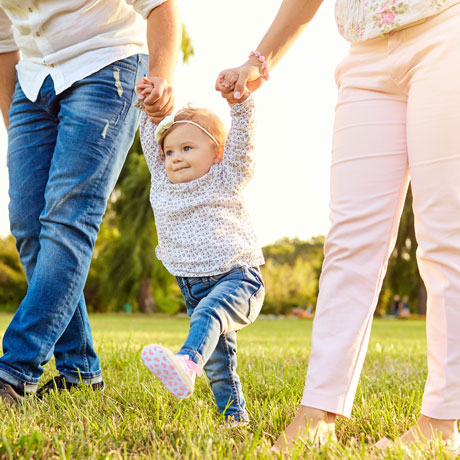Watching your child grow and develop is exciting. But, how can you know if your children are developing physically and cognitively at the rate that they should be? Here, the early childhood education professionals at Celebree Learning Centers explain developmental milestones, and what to look for as your child matures.
Children grow and develop at different rates. As such, understanding developmental milestones at every age can help you to monitor your child’s progress. Developmental milestones are specific attributes, characteristics and markers that most children reach at a specific age, and can include physical, social, behavioral, emotional and cognitive developments. While not meeting these milestones is not always indicative of developmental concerns, these developmental milestones should be used as reference guidelines to assess whether your child is continuing to developi in a healthy manner.
Infants will go through rapid changes while their bodies develop physically, emotionally and mentally. When transitioning from an infant to toddler age, children should be able to calm themselves with the help of a trusted adult. As they explore more, children at this age will begin to play around their peers, mimicking motions or activities from other children. They should begin to reach for, grab and release objects purposefully. Children will transition from rolling from back to front, to sitting assisted and then unassisted, and finally moving from scooting or crawling to finger walking or walking unassisted.
At this age, infants will begin to make word-like sounds, and even use one or two word sentences. They may show an interest in familiar people and places, new sights and sounds, and books. Keeping children at this age stimulated visually and auditorily, with plenty of space to safely explore, is crucial. Talking to children can help to soothe them, and promote verbal skills.
As toddlers grow into preschool-ready children, they will exude more independence. Typically, toddlers who are ready to progress into preschool will self-soothe, at times with the help of a favorite toy. Children at this age may even begin to look outwards at the concerns of others, and not just their own wants and needs. They will walk steadily and even try other more creative and vigorous motions such as running.
When transitioning from toddler to preschool, children often exhibit a desire to interact with objects and peers around them. In social situations, they may find a preferred playmate, and initiate and respond to brief conversations. As they enter preschool, toddlers should be allowed to explore and make independent yet supervised decisions.
Preschool children will continue to sharpen their physical, verbal, and social skills as they mature toward kindergarten readiness. They should be able to run, walk up and down stairs, and stand on one foot more smoothly than before. A preferred playmate may become a friend at this stage, and children will develop better speaking abilities—typically communicating in complete sentences of four to six words. With a better awareness of social expectations, they will begin to take turns, follow longer sets of directions, and try to solve problems. Cognitively speaking, they will start to engage more intimately with books by identifying pictures and words they know, identify simple shapes, count groups of objects under five, and be eager to learn about many new topics and ideas. It is important for educators and parents to give children at this age plenty of opportunities to try new activities, structured play and exercise.
By kindergarten, children should understand how to function well in a classroom setting: they follow detailed directions, may work on activities without distraction, play cooperatively with others and work toward solving problems on their own. Cognitively, children at this age will start recognizing patterns in word sounds, numbers and letters. School-aged children will speak coherently, and portray events with a distinct beginning, middle and end. Their conversations may become lengthy and detailed. By kindergarten age, fine motor skills will be sharper, and gross motor skills are more complex and sustained.
By understanding the changes your child is going through and providing ample room for them to explore and develop, your child will be well on their way to meeting their developmental milestones. For more information, or to speak with an experienced Celebree educator about how our programs support developmental milestones at every age, visit us at www.celebree.com.

